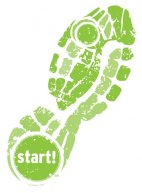“Walking is man’s best medicine.” -Hippocrates
It is estimated that Canadian adults spend approximately 3/4 of their day being sedentary. At Kinetic Physiotherapy, we want to encourage individuals to defy this statistic. One way we are promoting physical activity is through our Kinetic Steps Challenge. We are challenging participants to walk 10, 001 steps per day for the month of October. Here are some tips on walking technique and reasons why walking is a good form of exercise.
What are the top 10 reasons to walk?
- Walking reduces your risk and helps to manage type II diabetes
- Walking strengthens you heart and decreases the risk of heart disease
- Walking is good for your brain and helps prevent cognitive decline
- Walking is good for you bones and decreases risk of osteoporosis
- Walking improves mood and helps to alleviate symptoms of depression
- Walking reduces risk of colon and breast cancer
- Walking improves cardiorespiratory fitness
- Walking improves balance and coordination
- Walking helps to manage weight
- Walking tones and strengthens muscles
Walking tips:
What you need:
Supportive walking shoes that accommodate the length and width of your feet are essential. This will help to prevent injury and provide comfort while you are walking. Consider the use of a heart rate monitor and/or pedometer to add purpose to your walking workout and to help you set goals and provide variability.
Head, neck, and trunk:
- Keep your head up, chin level with the ground and look forward
- Keep your neck relaxed
- Keep your trunk upright and walk tall
- Tighten abs and buttocks
Shoulders and Arms:
- Your shoulders should be down, back and relaxed
- Bend your elbows slightly less than 90 degrees. Keeping your arms close to your body, swing your arms forward and back. Your hands should not cross the midline of your body.
Legs and Feet:
- When trying to walk fast, do not try to lengthen your stride. Lengthening your stride is inefficient and will cause you to fatigue faster. To go faster, take faster, smaller steps.
- Walk heel to toe. Your heel should contact the ground first, roll your foot forward and push-off with your toes.
How to get involved:
Kinetic Steps Challenge begins October 1, 2013. Spaces are still available. If you are interested in participating or would like more information, please give us a call at 905-637-1414, email us at kineticphysiotherapy@yahoo.ca or find us on Facebook https://www.facebook.com/10001steps
